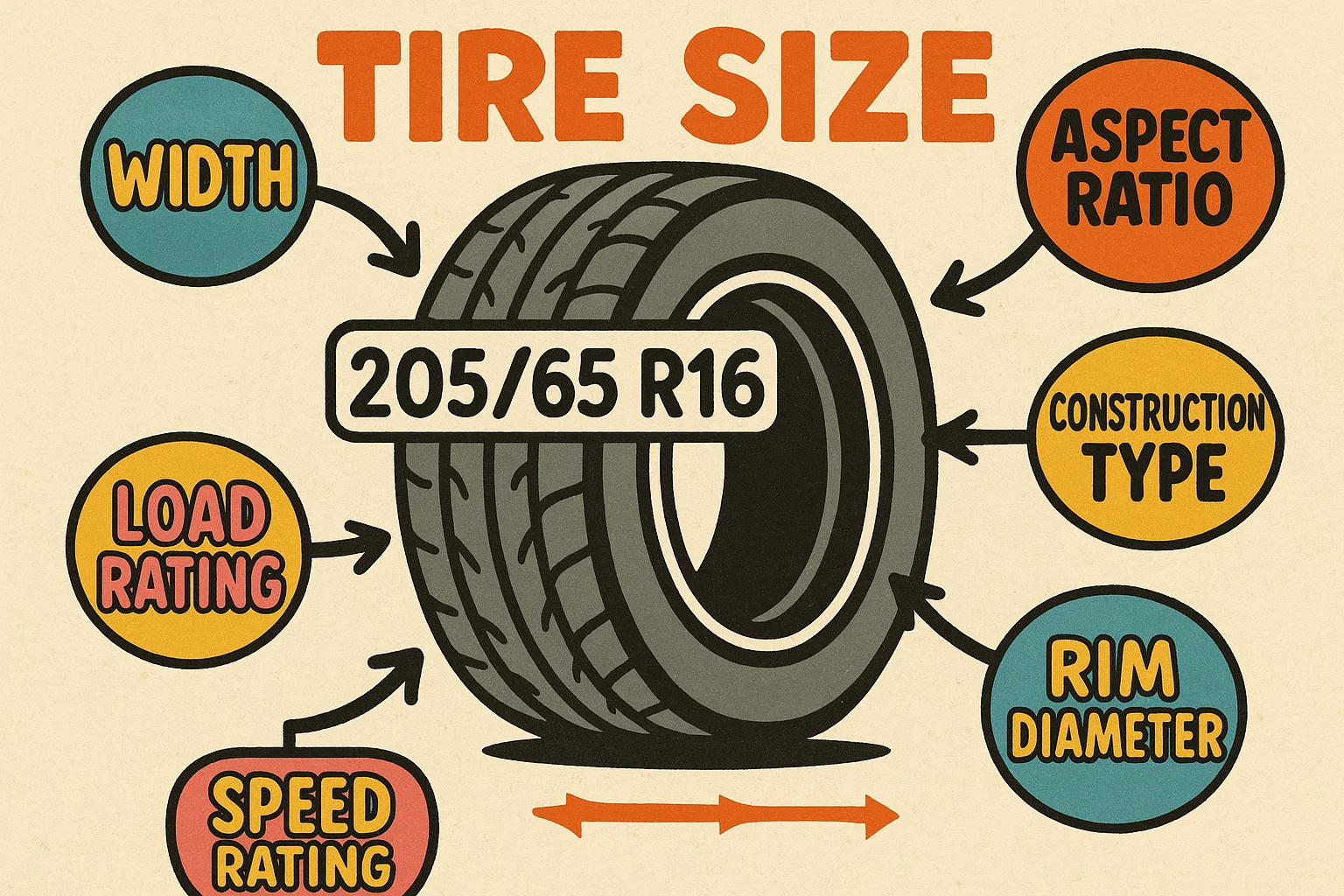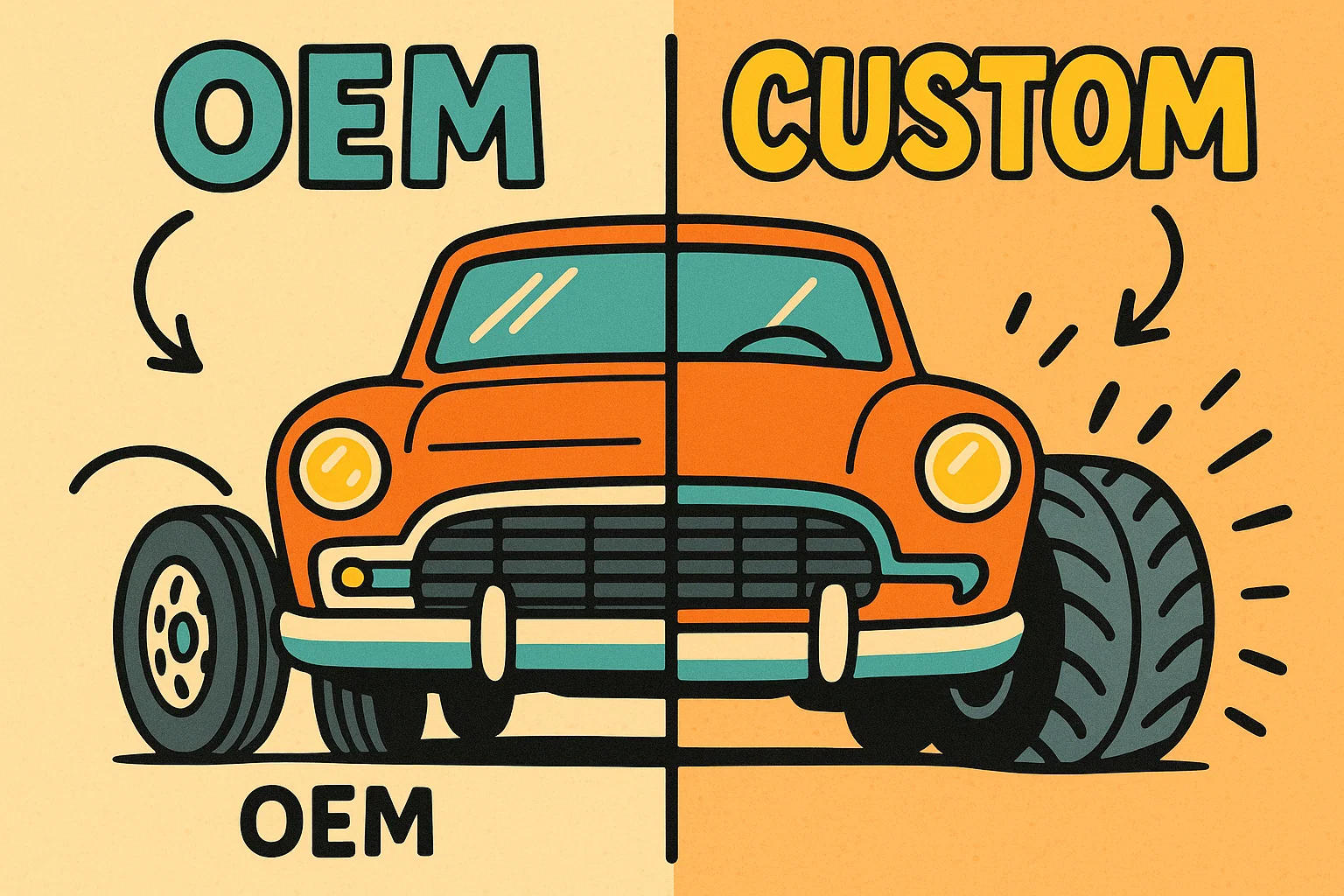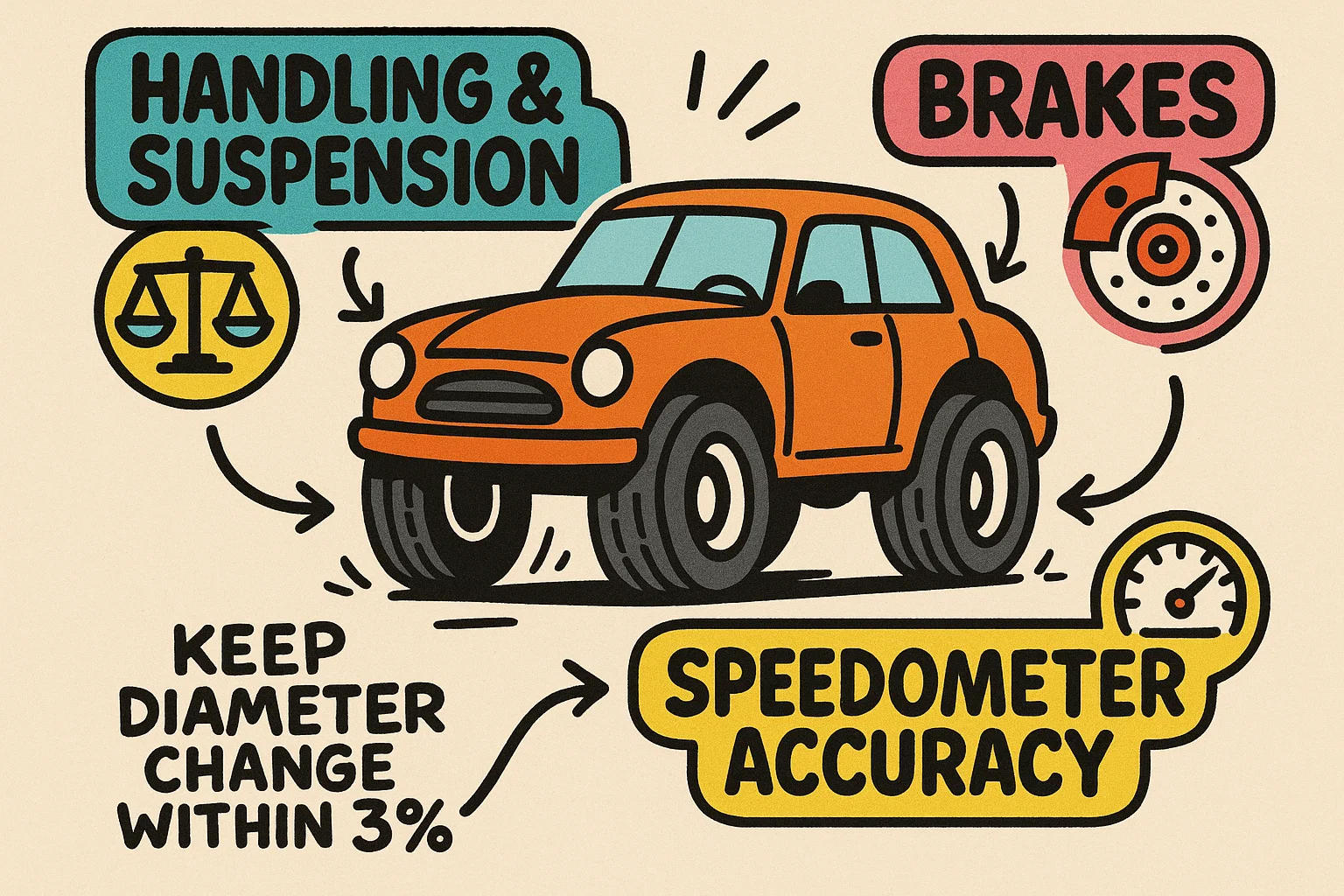Choosing the right tire isn’t just about numbers—it’s about safety, performance, and personality. In this guide, we go beyond the tire size calculator and dive deep into what tire size really means, why it matters, and how it connects everything from daily commutes to cinematic car chases.
What Does Tire Size Actually Mean?
Tire size isn’t just a random string of numbers and letters stamped on your sidewall—it’s a precise code packed with engineering insight. When you see something like 205/55 R16, it’s telling you critical information about the tire’s width, height, and rim diameter, all of which impact how the tire will perform and whether it fits your vehicle correctly.
Let’s break this down:
-
Width – The First Number (205): This is the section width, measured in millimeters, from one sidewall to the other. In our example, “205” means the tire is 205 mm wide. Wider tires generally offer better grip, especially in corners, but may reduce fuel efficiency.
-
Aspect Ratio – The Second Number (55): This two-digit number represents the aspect ratio, or the tire’s height as a percentage of its width. So a 55 aspect ratio means the height of the tire’s sidewall is 55% of its 205 mm width. A lower ratio typically means a sportier tire with better handling but a stiffer ride.
-
Construction Type – The Letter (R): The “R” stands for radial construction, which is standard in most modern tires. Radial tires have layers that run perpendicular to the direction of travel, providing durability and smooth performance.
-
Rim Diameter – The Final Number (16): This is the wheel diameter, in inches, that the tire is designed to fit. A tire labeled “R16” fits a 16-inch wheel. This number must match the wheel size exactly—there’s no wiggle room here.
🧩 Do you know? NASCAR drivers use custom tire sizing to create better grip on one side of the car for turning left at high speeds. The outside tires are often taller than the inside ones to help with cornering!

P-Metric vs. Euro-Metric Sizing
You’ll sometimes see tire sizes begin with a letter—typically “P” or no letter at all.
-
P-metric tires (e.g., P205/55 R16) follow U.S. standards, often optimized for passenger vehicles.
-
Euro-metric tires (e.g., 205/55 R16) are similar but don’t include the “P.” These are common in Europe and sometimes differ in load capacity for the same dimensions.
While the physical size might look the same, the difference in how they’re tested means they may not be direct substitutes in high-performance or load-sensitive situations.
Tire Size Code
Tire size codes can feel confusing at first glance—but they follow a consistent logic. To help decode the most common formats, here’s a real-world reference table built from industry-standard specifications. Each row shows how that tire size translates into key physical measurements.
|
Tire Code |
Width (mm) |
Aspect Ratio |
Rim Size (in) |
Overall Diameter (in) |
Circumference (in) |
|
205/55R16 |
205 |
55 |
16 |
24.88 |
78.14 |
|
215/60R16 |
215 |
60 |
16 |
26.16 |
82.21 |
|
225/45R17 |
225 |
45 |
17 |
25.00 |
78.54 |
|
235/70R16 |
235 |
70 |
16 |
28.95 |
90.94 |
|
265/75R16 |
265 |
75 |
16 |
31.65 |
99.40 |
|
285/45R22 |
285 |
45 |
22 |
32.10 |
100.78 |
These figures aren’t estimates—they’re calculated using standard tire measurement formulas and cross-verified with real-world data from major manufacturers such as Michelin, Goodyear, and TireRack. This ensures the values you see reflect actual tire dimensions used across a wide range of vehicles.
OEM vs. Custom Tire Sizes
Every vehicle rolls out of the factory with a specific tire size recommended by the manufacturer—this is known as the OEM (Original Equipment Manufacturer) tire size. It’s chosen based on careful testing to balance performance, safety, handling, and fuel economy. For most drivers, sticking with OEM specs is the safest and most efficient choice.
That said, some owners opt for custom tire sizes to enhance appearance, off-road capability, or ride characteristics. While upsizing or downsizing can be done safely, it’s not as simple as picking a bigger or smaller tire. Even a slight change in tire diameter, width, or aspect ratio can alter speedometer readings, affect braking, or reduce wheel clearance.
A common mistake is ignoring the overall impact of size changes on your car’s systems. Fitting wider tires, for example, might improve grip but also increase fuel consumption or cause rubbing inside the fender wells.

Load Index and Speed Rating
The load index is a two- or three-digit number that follows the tire diameter and specifies the maximum load the tire can carry at a certain inflation pressure. For instance, a load index of 95 means the tire can carry a maximum load of 1,521 lbs (690 kg).
The speed rating is usually a letter, such as T, H, or V, that indicates the maximum speed the tire can safely handle. For example, a tire with a “T” rating is safe up to 118 mph (190 km/h), while an “H” rating indicates a maximum speed of 130 mph (209 km/h).
How Tire Size Is Calculated
To understand tire size, a tire size calculator uses specific formulas to calculate the section height, total tire diameter, and overall circumference. Let’s break these calculations down:
Section Height Formula
The section height is a crucial measurement because it impacts the overall diameter of the tire. It’s calculated by multiplying the tire’s width by its aspect ratio.
Section Height = Aspect Ratio × Tire Width
For instance, if you have a tire that’s 215mm wide and the aspect ratio is 65%, the section height would be:
215 × 0.65 = 139.75mm.
Tire Diameter Formula
The overall diameter of the tire is determined by adding the wheel diameter and twice the section height (since the tire has a top and bottom sidewall).
Tire Diameter = Wheel Diameter + 2 × Section Height
If the wheel diameter is 16 inches (converted to millimeters as 406.4mm), the calculation would be:
406.4 + 2 × 139.75 = 685.9mm.
A tire size calculator will give you these calculations in both inches and millimeters, making it easy to compare different tire options and ensure compatibility with your vehicle’s specifications.
Considerations When Changing Tire or Wheel Size
When changing the tire or wheel size, several factors need to be taken into account, especially regarding safety and vehicle performance. The size of your tires affects more than just aesthetics. It impacts your vehicle’s handling, ride quality, fuel efficiency, and even the operation of systems like the suspension and brakes. Changing tire size can also affect the accuracy of your speedometer and odometer.
-
Handling and Suspension Impact: Larger or wider tires can affect your vehicle’s handling by altering the balance between the tire and suspension. A larger tire will typically increase the vehicle's contact patch, improving grip, but it may also cause the vehicle to become less responsive or more prone to hydroplaning in certain conditions.
-
Brake Compatibility: Larger tires can increase the weight of the vehicle, putting extra strain on your brakes. Ensure that your brakes can handle the additional weight.
-
Speedometer and Odometer Accuracy: Changing the overall diameter of the tire affects the revolutions per mile and, consequently, the accuracy of your speedometer and odometer. This can lead to inaccurate readings of your vehicle's speed and distance traveled.
When considering a tire change, it’s advised to keep the diameter within 3% of the original specifications to avoid compromising vehicle performance and safety.
Impact on Speedometer and Odometer
Tire size changes can do more than affect how your vehicle handles—they can also distort what your dashboard tells you. Both your speedometer and odometer rely on the tire’s rolling diameter to calculate speed and distance. When you change that diameter, you change the math.
Larger Tires = Lower Readings
When you install larger tires, they travel farther with each rotation. That means your car’s sensors—calibrated for the original tire size—register fewer revolutions per mile. As a result:
-
Your speedometer reads lower than your actual speed.
-
Your odometer undercounts the distance you travel.
So, while you might feel like you're cruising at 60 mph, your real speed could be closer to 64 mph. Over time, that discrepancy adds up—affecting not only safety but also things like lease mileage, fuel tracking, and maintenance intervals.
Smaller Tires = Higher Readings
Smaller tires rotate more often to cover the same distance. This leads to:
-
Overstated speedometer readings
-
Odometer inflation—you’ll log more miles than you actually drive
These changes might seem minor, but they can cause real issues—especially if you're relying on your instruments for precise driving or record-keeping.


